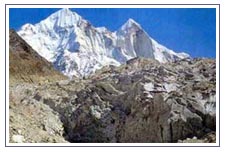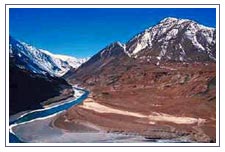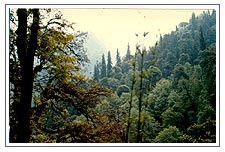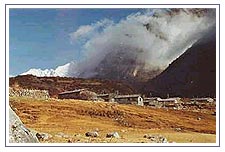
The
Himalayas with dazzling pinnacles of snow-covered ranges extend for 2,250-km
from the Namcha Barwa on the bend of the Tsang-po (Brahmaputra) to Nanga
Parbat on the Indus. The range runs east to west up to central-Nepal and
then takes a southeast to northwest direction. The average width of the
Himalayas is about 200-km.
The compositions of the forests on this mighty range are effected by the
combined effect of altitude, rainfall and latitude. The rainfall, mainly
from the monsoons, decreases from the east to the west. Comparatively, in
winter, due to the influence of tropical west wind drift, the northwest
areas have more precipitation in the form of rain and snow. From these snow
covered ranges with big glaciers, flow the great rivers that have made the
Indo-Gangetic plain one of the most fertile in the world and the heart Land
of India.
Climatic Variation In The Himalayas
The Himalayan Alpine climate
varies according to the elevation. It gets colder as the elevation increases
and gets wetter as the elevation drops. As a result the temeparture and
climatic changes in the Himalayan regions change very quickly. All of a
sudden there can be occurances of monsoons, floods, high winds, snowstorms
and other types of precipitation, which makes the climate over here quiet an
unpredictable and dangerous one.
The two major seasons of the Himalayan region are winter and summer. During
the winter the region recieves the maximum snow with very icy temperatures.
Summer are quiet mild over here, making the places overe here quiet good
summer holiday hideouts. Usually throughout the year te Alpine Himalayan
region recieves Snow.
Beyond The Monsoon

The
regions such as Ladakh & Zanskar that lie to the North of the main
Himalayan range and escape the full impact of the monsoon. Humidity is
always low in these regions, and receives only a few centimeters of rainfall
a year. These regions also experience some of the coldest temperatures
anywhere in the world, and it doesn't get any warmer till the spring
season in late April or early May.
In June, daytime temperatures frequently rise to the mid 200Cs, the snow on
the passes melts and most of the treks can be undertaken from then on until
the middle of October. Heavy rainstorms can occasionally be experienced in
July and August, and River crossing should be undertaken with great care at
this time. By September the conditions are ideal, and they normally remain
so until late October even though nigh-time temperatures may fall below
freezing. By November, the early winter snows fall on the passes closest to
the Himalayas. In winter the villagers still travel, enduring the intense
cold, to follow the valley floors where River crossings are no longer a
problem.
After October the daytime temperatures drop, but the weather is generally
settled until the middle of November when the first of the heavy winter
snows fall on the high mountain passes. Winter months from December to March
are often bleak. April and May are characterised by heavy precipitation,
which falls as snow in the mountains, precluding trekking over the passes
until the spring snows melt in June.
Most of the hill states of the West Himalayas including Kangra and Chamba,
the Kullu valley, Shimla in Himachal and most regions of the Garhwal and
Kumaon in Uttaranchal come under the influence of the Indian monsoon. Both
Darjeeling and Sikkim are subject to the Indian monsoon that sweeps up from
the Bay of Bengal, bringing heavy rainfall from early June until the end of
September. The post-monsoon months of October and November provide settled
conditions, with clear views of the mountains, although nighttime
temperatures above 3,500m frequently fall below freezing.
Forest Cover - The Glory Of The Himalayas

Because
of the constant most of the Himalayan regions have a harsh environment
therefore few animals and plants can survive over here. The few plants that
do inhabit the Alpine consist of rhododendrons, the tea plant and shrub type
plants. They have to adapt to the freezing temperatures, high winds and to a
short growing season. That is why most of the plants grow low to the ground.
The Hindustan-Tibet road now called National Highway No. 22 takes one right
across the Himalayas from the plains over forested mountain ranges, along
the Sutlej through the gorge in the great Himalayan range near Shipkila on
the Indo-Tibet border. One of the most interesting and accessible areas are
the forests on the ridge line that form the Indo Gangetic watershed on which
lie Shimla, Narkanda and the most beautiful forests of silver Fir starting
from Narkanda. Part of the Hindustan-Tibet road run along this watershed
ridge.
From the plains to the snow clothed mountains, one goes through fine
forests of Pine, Deodar, Fir, Oak, Rhododendron, Birch and finally between
the tree line and the snows, rich alpine pastures. Inhabited areas, on
cultivated terraced fields, can be seen women in their customary colourful
clothes decorating the hillside like alpine blossoms.
The mountain fauna that are found in the Himalayan Alpine are similar to
the mountain animals found in the surrounding areas of the Himalalayas. Some
animals that have adapted the Himalayan climate include the mountain goat,
which has a thick coat for warmth and strong hooves for running up the rocky
slopes.
The Awesome Himalayan Panorama

To
know the mountains one has to be amongst them. In the evening as one begin
settling down so do the mountains, valleys and clouds. It is a wonderful
sight to see a sea of clouds sinks in repose in the deep valleys. At the
same time the setting sun converts the surrounding peaks into molten gold
which gradually fade away into pale pink and steel grey.
At night, the moon lends a peculiar charm to the snow transferring the
rugged peaks and ridges into soft contours. The hamlets in the valleys,
surrounded by fields, are in deep slumber. The silence of the mountains is
complete. The only sound one can hear is of the campfire.
In the morning, the rising glow of the sun reflects from peak to peak and
then descends to the lower slopes awakening all. The sun's warmth
rouses the clouds to gradually climb the mountains, hugging the valley sides
as they rise and engulf the peaks with their crowns of snow. This is an
experience so vivid and revitalizing that it can never be forgotten.
In recent years, there has been great emphasis on
saving the trees but the actual progress has been insignificant. Day by day,
the trees are being destroyed and being cut down without replacement and
without a thought for our children's future. Overgrazing and ruthless
assault on herbs is destroying the meadows and pastures.
In the absence of forests, there will be less precipitation in the form of
rain and snow - leaving the grand peaks without their white mantle. This
ecological damage, if not redeemed, will lead to catastrophes in the form of
extreme floods, droughts, forests fires and disappearance of wildlife.
The diversity of the plants, herbs, flowers, landscapes is truly stunning
and reflects Nature's brilliant ecological plan. The lines taken from
Devistotra, a Hindu Shastra, (500 BC) presents quite a clear picture of the
Himalayan lands:
"So long as this land will have mountains, forests and pastures
that long the earth will survive, sustaining you and the coming generations."






 The
Himalayas with dazzling pinnacles of snow-covered ranges extend for 2,250-km
from the Namcha Barwa on the bend of the Tsang-po (Brahmaputra) to Nanga
Parbat on the Indus. The range runs east to west up to central-Nepal and
then takes a southeast to northwest direction. The average width of the
Himalayas is about 200-km.
The
Himalayas with dazzling pinnacles of snow-covered ranges extend for 2,250-km
from the Namcha Barwa on the bend of the Tsang-po (Brahmaputra) to Nanga
Parbat on the Indus. The range runs east to west up to central-Nepal and
then takes a southeast to northwest direction. The average width of the
Himalayas is about 200-km.  The
regions such as Ladakh & Zanskar that lie to the North of the main
Himalayan range and escape the full impact of the monsoon. Humidity is
always low in these regions, and receives only a few centimeters of rainfall
a year. These regions also experience some of the coldest temperatures
anywhere in the world, and it doesn't get any warmer till the spring
season in late April or early May.
The
regions such as Ladakh & Zanskar that lie to the North of the main
Himalayan range and escape the full impact of the monsoon. Humidity is
always low in these regions, and receives only a few centimeters of rainfall
a year. These regions also experience some of the coldest temperatures
anywhere in the world, and it doesn't get any warmer till the spring
season in late April or early May.  Because
of the constant most of the Himalayan regions have a harsh environment
therefore few animals and plants can survive over here. The few plants that
do inhabit the Alpine consist of rhododendrons, the tea plant and shrub type
plants. They have to adapt to the freezing temperatures, high winds and to a
short growing season. That is why most of the plants grow low to the ground.
Because
of the constant most of the Himalayan regions have a harsh environment
therefore few animals and plants can survive over here. The few plants that
do inhabit the Alpine consist of rhododendrons, the tea plant and shrub type
plants. They have to adapt to the freezing temperatures, high winds and to a
short growing season. That is why most of the plants grow low to the ground. To
know the mountains one has to be amongst them. In the evening as one begin
settling down so do the mountains, valleys and clouds. It is a wonderful
sight to see a sea of clouds sinks in repose in the deep valleys. At the
same time the setting sun converts the surrounding peaks into molten gold
which gradually fade away into pale pink and steel grey.
To
know the mountains one has to be amongst them. In the evening as one begin
settling down so do the mountains, valleys and clouds. It is a wonderful
sight to see a sea of clouds sinks in repose in the deep valleys. At the
same time the setting sun converts the surrounding peaks into molten gold
which gradually fade away into pale pink and steel grey.